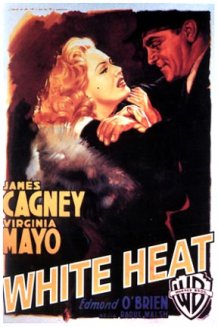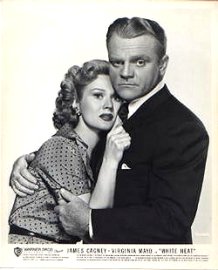Who is the blogger?
Archived entry
White Heat (1949)
Violence in Film: Queasy Stomachs
In "White Heat", Jimmy Cagney shows us the 1949 version of good old-fashioned gangster movie violence to good advantage. The ultimate "tough guy" is not too tough to watch for those of us with queasy stomachs, unlike Scorsese's "Good Fellas".
Well, I missed this week’s screening of “Goodfellas” on TVO's Saturday Night at the Movies, second in the series on “Violence in the Movies”.
What can I say? I was in a kind of survival mode of my own what with the heat wave and the smog warnings and all. After several nights of partial insomnia, a bout of nasty stomach flu for me and the family followed by an even nastier upper respiratory tract infection, I just wasn’t up to it. “Do I need to subject myself to this?” I asked myself late on Saturday night - “No, not for love nor money.”
 I did, however, watch “White Heat”. I could put up with the good old-fashioned gangster movie type of violence, at least for a couple of hours.
I did, however, watch “White Heat”. I could put up with the good old-fashioned gangster movie type of violence, at least for a couple of hours.
As was observed at one point during the Interviews, being a 1940s film, none of it was very real – the depiction of violence, that is. Sure, there were lots of “shoot-em up, blow’em up scenes” to go around. Cody Jarrett, played by James Cagney, comes off as a vicious, slightly psychotic old-style gangster. But, for all the victims who got blown away along the way in “White Heat”, I knew that none of it would bother my queasy stomach in the same way that just a couple of scenes of “Goodfellas” would.
 Yes, you definitely got the picture that Jarrett was a fiendishly violent character – without exposing your mind to the full picture of what real-life violence actually involves. Scenes such as the one where Jarrett kicks a chair out from under the hapless Verna while she admires her mink coat in the mirror or where he sends one of his men back into the cabin to kill their badly injured comrade help to establish beyond doubt that the character of Cody Jarrett is a relentlessly violent individual with or without a gun in his hand.
Yes, you definitely got the picture that Jarrett was a fiendishly violent character – without exposing your mind to the full picture of what real-life violence actually involves. Scenes such as the one where Jarrett kicks a chair out from under the hapless Verna while she admires her mink coat in the mirror or where he sends one of his men back into the cabin to kill their badly injured comrade help to establish beyond doubt that the character of Cody Jarrett is a relentlessly violent individual with or without a gun in his hand.
No, you don’t get the full shock value that is attached to true-to-life violence in the movies. The stomach-churning, mind-scarring, emotion-numbing impact isn’t there in a film like “White Heat”. It is easier to watch a film like “White Heat” and come away with a sense, probably much like the original matinee audiences did, that you have been entertained for a couple of hours. The bad guy is bad, but he gets his just deserts in the end. Everyone walks away feeling that everything is basically okay with the world. That is just the way things worked in Hollywood in the 1940s if you wanted a hit movie.
 Not that this was such a good thing. I don’t find that the 1940s recipe for a hit movie was somehow superior (a big star, James Cagney, a delicious dish, Virginia Mayo, a little pseudo-psychology, a good guy - bad guy story line and lots of gunplay). During the Interviews, Roger Corman refers to the escalation of the depiction of violence in films as a crass money making venture – “If you can get a hit movie for 22 buckets of blood and $5million, what’s to stop you from going for 50 buckets of blood (and a smaller budget??) the next time around?” Both approaches, it seems to me, lead to mindless entertainment and contribute to the problem of an unexamined life.
Not that this was such a good thing. I don’t find that the 1940s recipe for a hit movie was somehow superior (a big star, James Cagney, a delicious dish, Virginia Mayo, a little pseudo-psychology, a good guy - bad guy story line and lots of gunplay). During the Interviews, Roger Corman refers to the escalation of the depiction of violence in films as a crass money making venture – “If you can get a hit movie for 22 buckets of blood and $5million, what’s to stop you from going for 50 buckets of blood (and a smaller budget??) the next time around?” Both approaches, it seems to me, lead to mindless entertainment and contribute to the problem of an unexamined life.
Personally, I don’t feel like I need the shock effect of guts galore as orchestrated by a scriptwriter or a director in order to come to terms with the extent of crime in society, the viciousness of violence, the existence of evil or the recognition of tragic consequences any of these things. I am already utterly and thoroughly convinced. I don’t like to dwell on such topics. Although I certainly try to avoid exposing my eyes and my mind to graphic depictions of such things unnecessarily, I don’t think that I fall into the category of therefore being “naïve ”.
I can understand why people want to raise such issues through film. Of course I m not talking about the kind of “gratuitous violence” in film that was referred to a couple of paragraphs above. I am speaking of the “thoughtful, intentional use of violence” in film in order to make some kind of a statement. Supposedly, Martin Scorsese used violence in this way in “Goodfellas”
One of the difficulties of filmmaking, as with other modern art forms, is that, while it may be good for “raising issues” and “making statements”, it rarely seems capable of supplying any answers. It doesn’t give people any way of coming to terms with the issues raised. Films can show us certain things with painful accuracy - “People do horrendous things. A minority are so perverted as to like violence, death and suffering. Lots of us, if left to our own devices, are not above using violence to get what we want. Often enough, people who do bad things get away with it, at least in the short run.” Well, what are you supposed to do with all that?
I am afraid that I can’t agree with Mr. Jesse Wente, as recorded during the “Interviews”. Just because I understand something better, perhaps gaining some new insight into the intricacies of how violence works and where it comes from through watching movies, this does not mean that there will somehow be less violence off-screen. I find this to be a very naïve point of view. (I am referring to the current popular point of view that education is the key to changing people and their behaviour.) I might possibly be able to justify on-screen violence as a means to explore the problem of violence, but to ascribe a transformative element to such depictions simply goes beyond what the vast majority of modern-day films can do and do do. They don’t have the equipment necessary.
Suggested Reading:
- IMDb's Message Boards - Look under 'Cagney’s greatest performance': “Cagney, gangster extraordinaire, singing and dancing? While I’ll never!”
- My article: Transformative On-screen Violence
- Crime and Punishment : A film with a different perspective
- How are you doing on running your life? Need to call in a new director?



